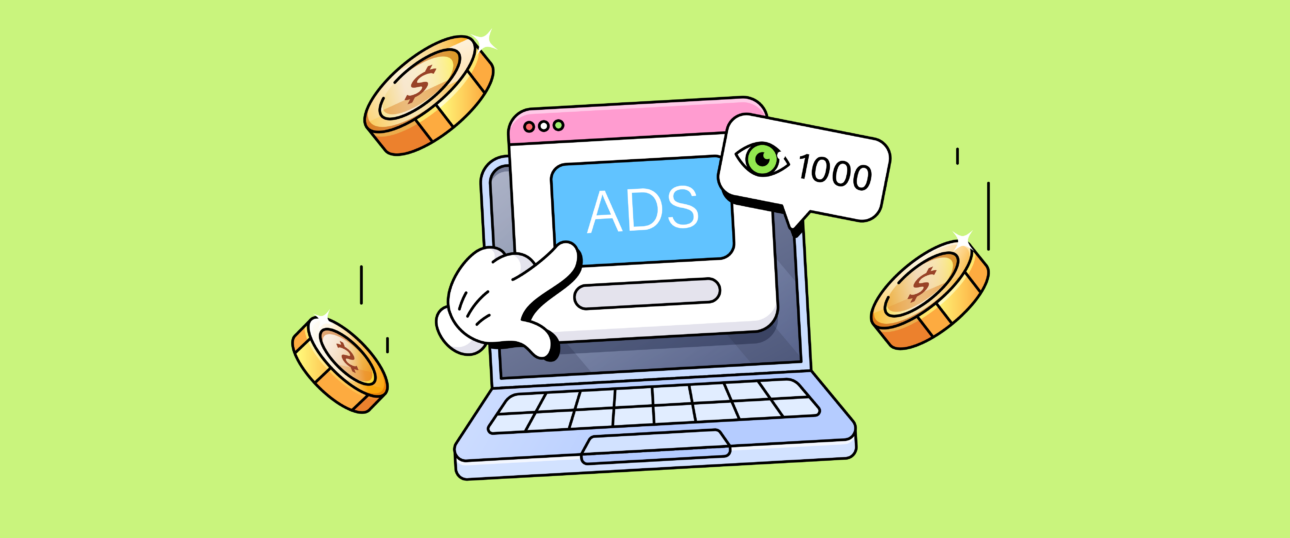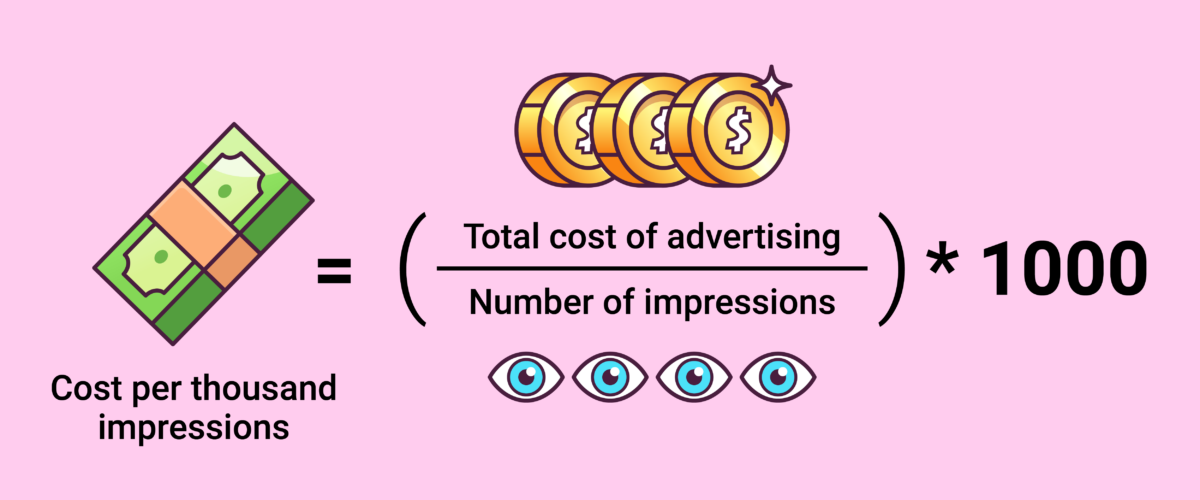
What Does CPM Stand for in Marketing – Formula CPM
- Is CPM the Same as CPT?
- What Is CPM in Digital Marketing?
- CPM vs CPC vs CPA – what to choose for your advertising
- How to Calculate CPM
- What is a good CPM?
- Which factors influence CPM
- About the role of CPM in marketing
- Advantages and Disadvantages of CPM
- How to optimize your CPM campaigns to maximize ROI
- What is SmartCPM?
- Conclusion
Among the numerous pricing models in digital advertising, CPM (cost per mille), or cost per thousand impressions, holds a special place. CPM meaning in marketing has been a standard for many years for brands that strive for mass audience reach. Why is it so popular, and what aspects should be taken into account when working with CPM? In this article, we will tell you how it works, what it depends on, and how to optimize campaigns for the best results in digital marketing.
Is CPM the Same as CPT?
Not exactly. While CPT (Cost Per Thousand) can be used interchangeably, CPM is the more widely accepted abbreviation in online advertising and marketing terminology. So, what does CPM stand for? It stands for Cost Per Mille, meaning the cost per thousand ad impressions.
What Is CPM in Digital Marketing?
Imagine an ad that doesn’t require an instant response from the user – a click or a purchase. Instead, it simply appears in front of their eyes, forming an impression and fixing the brand or product in their mind. This ad format is usually paid for based on the CPM pricing model.
CPM definition – Cost Per Mille translates to cost per thousand impressions. That is, the advertiser pays for every 1000 times their ad appears on users’ screens, regardless of whether they interacted with the ad or not, a key point in CPM advertising. If you’re wondering how to figure out CPM, it’s typically calculated by dividing the total cost of the campaign by the number of impressions (in thousands). Also, keep in mind that CPM full form is often used in discussions to clarify terminology: it literally means “Cost Per Mille,” with mille being Latin for one thousand.
For example: you run an ad campaign with a CPM cost of $2. This means that for every 1,000 times your banner is shown, you will pay $2. If your ad is shown 50,000 times, the total cost of the campaign will be $100.
This model is most often used to increase brand awareness, promote events like sales, webinars, or giveaways – when the main goal is not direct conversion but visibility and ad viewability.
CPM vs CPC vs CPA – what to choose for your advertising
The main advantage of CPM is that it is suitable for broad reach and interest generation, whereas CPC and CPA are for more focused goals with precisely measurable results:
- CPC (Cost Per Click) is ideal for those who want to maximize the return on each click. For example, your CPC is $0.5, and you get 200 clicks; then the cost would be $100.
- CPA (Cost Per Action) is the best option for those focused on specific results (like increased sales). A CPA rate of $10 means you pay $10 for each successful sale through advertising.
The primary difference lies in how performance is measured: CPM prioritizes impressions, CPC focuses on clicks, and CPA on final actions.
How to Calculate CPM
Formula CPM
You can calculate the CPM cost using a simple formula:

Let’s take an example: you spent $500 on a campaign that brought 200,000 impressions.
CPM = ($500 / 200,000) × 1000 = $2.5
This CPM calculation helps evaluate the effectiveness of advertising spend and compare it across different digital advertising channels
What is a good CPM?
A good CPM metric depends on the industry, region, and ad format. For example, video ads and premium display ads tend to have a higher CPM due to greater engagement. On platforms like YouTube, the average YouTube CPM might be around $5–$10 in the U.S., while TikTok CPM can vary significantly. In some past years, YouTube CPM rates were lower, reflecting the platform’s growth and changing digital marketing trends.
Which factors influence CPM
CPM rates are a dynamic parameter that depends on many factors.
Audience parameters
- Demographics (age, gender, location, income level). Advertising for a financially capable target audience usually has a higher CPM. In developed countries, it can reach $10-15, while in some Asian countries it will be at the level of $1-2.
- Interests and behavior. Users with specific interests (like travel, premium brands) are valued higher by advertisers.
- Device type: ads displayed on desktops tend to have higher CPMs than on mobile devices.
Ad quality and format
- Unique and engaging creatives increase CPM.
- Video ads, interactive banners, and non-standard formats demand more budget.
- The larger and more visible the ad format, the higher the cost.
Website characteristics
- Well-known and reputable websites with high traffic have higher CPMs.
- The quality of content on the website also affects the cost of display.
- Matching the audience of the website to the advertiser’s target audience.
- Different levels of engagement, which may cause YouTube to have a higher CPM compared to Facebook, for example.
Time factors
- Peak hours and seasonal spikes (like holidays) increase CPM rates.
- Timing impacts how frequently users see your ad and what you pay per mille.
Competition
- More competition for specific audiences or keywords leads to higher bids.
- Niches like finance or gambling are known for very high CPMs.
Technological factors
- Ads that aren’t visible don’t get charged.
- Frequency capping and personalized ads based on user data impact costs.
About the role of CPM in marketing
In marketing, CPM is used to create mass reach. For example, for:
- advertising of a new brand, when it is necessary to create a first impression with a wide audience.
- retargeting – repeated displays stimulate interest and trust in the brand.
- media advertising – banners, video ads and other formats.
In Internet marketing, CPM acronym is used to evaluate the effectiveness of advertising campaigns. The indicator helps to understand how effectively your message reaches the target audience.
However, in affiliate marketing, the CPM model is used less often, as most arbitrageurs are focused on conversions (CPA). Nevertheless, the model can be useful for testing new audiences or ad formats to determine their effectiveness before launching campaigns based on other models.
Advantages and Disadvantages of CPM
To decide whether CPM is right for you or not, you need to know about its pros and cons.
Advantages of CPM:
- Pay-per-view advertising is an easy way to increase your visibility and be memorable to your audience. Constant display ads build a positive impression.
- Reach a huge audience with a relatively small budget. This is especially useful when launching new products or campaigns.
- Possibility to calculate the budget of an advertising campaign in advance, since the cost per thousand impressions is usually fixed.
- Flexible targeting settings by audience, geography, interests, and other parameters.
- CPM is ideal for the upper level of the sales funnel – attracting attention and creating interest in a product or service at the initial stages of the marketing funnel.
Disadvantages of CPM
- Payment is made for impressions, not for user actions. This means that not all users who see an ad will necessarily click on the link or make a purchase.
- Repeatedly showing the same ad can annoy users, reducing the effectiveness of the ad.
- Measuring the exact return on investment (ROI) in CPM can be difficult, especially if the goal of the campaign is to increase brand awareness rather than direct sales.
- Some of the ad impressions may be for users who are not your target audience. And this is an inefficient use of your budget.
- In niches with high competition, CPM rates may be too high.
- Due to the large number of ads, users often miss them. This develops banner blindness, thus reducing the effectiveness of CPM campaigns.
How to optimize your CPM campaigns to maximize ROI
To get the most from your CPM campaigns:
- Focus on ad viewability: Ensure your ads appear in visible spots.
- Improve creative quality: Better ads = better engagement = higher ROI.
- Test different ad formats and platforms.
- Use SmartCPM (explained below) to optimize bidding.
What is SmartCPM?
SmartCPM is a technology that optimizes pay-per-thousand impressions campaigns. It uses algorithms that analyze user behavior data and automatically sets the optimal cost per thousand impressions. This increases the effectiveness of ad campaigns and reduces costs.
Conclusion
The CPM model is a powerful tool for achieving broad reach and brand building. Despite certain limitations, it remains one of the most popular pricing models in digital marketing. However, to maximize its effectiveness, it’s important to consider the specifics of your audience. By properly combining CPM and CPC/CPA, you can form successful strategies and get impressive results.
Disclaimer: The views, opinions, and content expressed in this article are those of the author and do not represent the official position, policies, or endorsements of the company.
